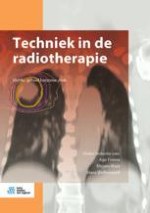Samenvatting
Inhoud – 1 Ontwikkeling van de radiotherapie – 2 Radiobiologie – 3 Rol van de radiotherapie – 4 Vormen van radiotherapie – 5 Route van de patiënt over de afdeling – 6 Kwaliteitszorg – 7 Het radiotherapieteam – De ontdekking van de röntgen- en gammastraling in 1895 leidde in de twintigste eeuw tot de ontwikkeling van de radiotherapie. Om straling effectief en verantwoord te kunnen toepassen als therapie bij verschillende aandoeningen, werd steeds meer kennis vergaard over de benodigde doses en de tolerantie van het omliggende weefsel. Zo werd de dosimetrie ontwikkeld en kwam steeds meer apparatuur beschikbaar om aan de uiteenlopende eisen te voldoen. De afgelopen twintig jaar heeft de ontwikkeling van computerhardware en -software grote invloed gehad op de praktische toepassing van radiotherapie. De radiobiologie heeft veel van de in de praktijk opgebouwde kennis nader verklaard en werd zo een bron voor verdere ontwikkelingen. Radiotherapie wordt uitgevoerd via uitwendige bestraling (megavoltstraling, orthovoltstraling, elektronenstraling of protonenstraling) of inwendige bestraling (brachytherapie). De behandeling van de patiënt wordt uitgevoerd door een multidisciplinair radiotherapieteam. Daarbij worden verschillende stappen gevolgd, van het informeren van de patiënt, het uitvoeren van diverse onderzoeken – vaak met behulp van MRI- of PET-CT-scans –, het bepalen van de juiste positionering en het vervaardigen van fixatiemiddelen tot het maken van een bestralingsplan en het uitvoeren daarvan. Kwaliteitszorg heeft daarbij voortdurend de aandacht.

